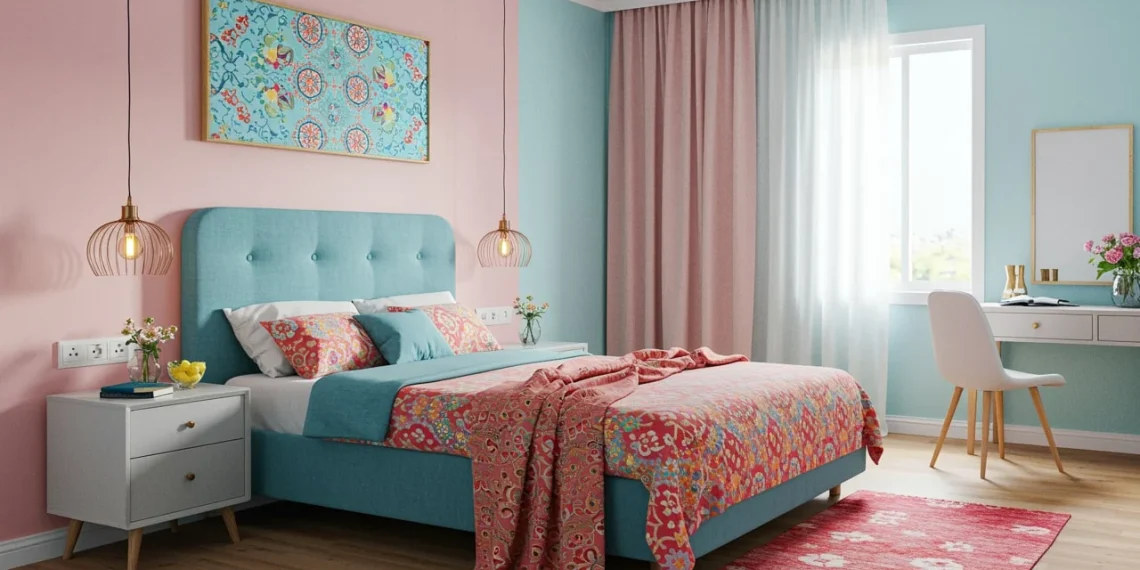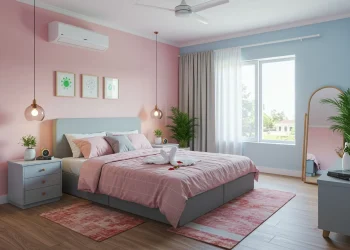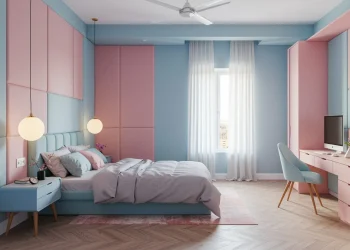Creating the perfect bedroom sanctuary goes beyond comfortable bedding and quality mattresses. The colors surrounding us as we sleep have a profound impact on both our physiological responses and cultural well-being. For Indian households, this becomes even more meaningful when we consider how ancient wisdom and modern sleep science converge to create spaces that honor tradition while optimizing rest.
Understanding how bedroom colors sleep patterns intersect with our cultural preferences can transform your nightly rest experience. Whether you’re drawn to traditional vastu bedroom colors or seeking the most effective sleep inducing colors India has embraced for centuries, the right color palette can significantly enhance your sleep quality while maintaining cultural harmony in your home.
The Science Behind Color and Sleep: How Hues Affect Your Rest
Modern sleep research has revealed fascinating insights into how different colors influence our circadian rhythms and sleep patterns. The human brain processes color through specialized cells in our retina called intrinsically photosensitive retinal ganglion cells, which directly communicate with our body’s internal clock located in the hypothalamus.
Blue light, particularly in the 460-480 nanometer range, has the most significant impact on suppressing melatonin production. This natural sleep hormone typically begins increasing in the evening, signaling to our body that it’s time to rest. When our bedrooms contain bright blues, whites, or cool-toned colors, they can inadvertently keep our minds alert when we should be winding down.
Research conducted by Dr. Chris Idzikowski at the Edinburgh Sleep Centre found that people sleeping in blue bedrooms averaged the least amount of sleep at just under six hours per night. Conversely, warm colors like soft greens, muted yellows, and gentle earth tones promoted longer, more restful sleep periods.
The autonomic nervous system also responds differently to various colors. Warm, muted tones tend to activate the parasympathetic nervous system, which controls our “rest and digest” functions. Cool, bright colors often stimulate the sympathetic nervous system, triggering our body’s alert response. This physiological understanding provides the scientific foundation for why certain bedroom colors sleep enhancement works so effectively.
Cortisol levels, our primary stress hormone, also fluctuate based on color exposure. Studies have shown that individuals in environments dominated by soft, warm colors maintain lower evening cortisol levels, making it easier to transition into deep sleep phases. This scientific evidence aligns remarkably well with traditional color wisdom found in Indian cultural practices.
Traditional Indian Color Wisdom: Ancient Knowledge Meets Modern Sleep Science
Indian tradition has long recognized the profound connection between color and well-being, with vastu bedroom colors offering specific guidance for creating harmonious sleeping spaces. According to Vastu Shastra, the bedroom should primarily feature colors that promote tranquility, intimacy, and rest while maintaining the balance of the five elements.
Soft pink and rose tones have been traditionally favored in Indian bedrooms for their association with love, compassion, and gentle energy. These colors correspond to the heart chakra and are believed to promote emotional healing during sleep. Modern research supports this wisdom, as pink has been shown to reduce aggression and promote feelings of calm and security.
Gentle green shades, representing nature and growth in Indian philosophy, create a sense of balance and renewal. Traditional texts describe green as the color of healing and restoration, which aligns with contemporary findings that green environments can lower blood pressure and reduce eye strain. Many Indian families have historically incorporated green through natural elements like plants or soft green textiles.
Warm yellow and gold tones, sacred colors in Hindu tradition representing knowledge and prosperity, can be used strategically in bedrooms. While bright yellows might be too stimulating for sleep, muted golden hues create a sense of warmth and security. These colors are often incorporated through silk fabrics or brass accents rather than wall colors.
Earth tones like terracotta, clay, and soft browns connect us to the grounding element in Vastu principles. These colors promote stability and security, essential feelings for deep rest. Traditional Indian homes often featured these natural pigments derived from local soil and minerals, creating an inherent connection between the dwelling and the land.
The concept of avoiding stark white or black in bedrooms also has scientific backing. Pure white can feel too clinical and bright for relaxation, while black might create feelings of heaviness or depression in some individuals. Traditional Indian color palettes instead favor off-white, cream, and warm neutral tones that feel both pure and comforting.
Regional Color Traditions: Celebrating India’s Diverse Sleep Sanctuary Styles
Different regions across India have developed unique approaches to bedroom colors that reflect local climate, available materials, and cultural practices. Understanding these regional preferences can help you choose sleep inducing colors India has perfected across diverse environments.
In Rajasthan, traditionally hot and arid regions have favored cooling colors like soft blues and whites, often accented with vibrant textiles. However, these bright blues are typically used in small doses through decorative elements rather than as dominant wall colors. The primary palette remains cool neutrals that help psychologically reduce the perception of heat while maintaining visual interest through intricate patterns and textures.
South Indian traditions often incorporate deeper, richer colors influenced by temple architecture and tropical environments. Muted maroons, deep greens, and golden yellows appear in traditional bedroom settings, balanced with plenty of natural wood tones. These colors work well in regions with intense sunlight, creating cool, cocoon-like interiors that promote rest during hot afternoons.
Bengali households have historically favored soft, artistic color combinations inspired by natural landscapes. Gentle teals, inspired by river waters, combined with warm ochres reflecting fertile soil, create bedrooms that feel both sophisticated and restful. These combinations work particularly well in humid climates, as they evoke freshness without feeling cold.
Mountain regions like those in Himachal Pradesh and Kashmir traditionally used warmer colors to psychologically combat cold temperatures. Rich burgundies, warm oranges, and deep forest greens create cozy, enveloping spaces that promote security and warmth. These colors help maintain emotional comfort during long winter months when natural light is limited.
Coastal regions have developed palettes inspired by marine environments, using soft coral tones, muted sea greens, and sandy beiges. These colors reflect the calming influence of ocean environments while avoiding the bright blues that might overstimulate the sleep system.
Seasonal Color Adaptations: Harmonizing Your Sleep Environment with Nature’s Rhythms
Traditional Indian wisdom recognizes that our color needs change with seasons, and modern sleep science supports this cyclical approach to bedroom design. Adapting your bedroom colors seasonally can optimize your sleep throughout the year while maintaining cultural authenticity.
During summer months, when temperatures soar and daylight hours extend, cooler color palettes help create psychological relief. Soft mint greens, pale lavenders, and cool grays can be introduced through bedding, curtains, and decorative elements. These colors help signal to your brain that the environment is cool and restful, even when external temperatures remain high. Traditional Indian homes often achieved this through white cotton fabrics and light-colored stone floors.
Monsoon season calls for colors that combat humidity and gloominess while promoting emotional balance. Warm, muted yellows and soft peach tones can counteract the gray, overcast skies common during rainy months. These colors help maintain emotional equilibrium and energy levels when natural light is reduced. Traditional approaches included using natural dyes in textiles that could be easily changed with the seasons.
Winter months benefit from slightly warmer color palettes that psychologically increase feelings of warmth and security. Deep burgundies, warm browns, and rich golden tones can be incorporated through heavier textiles and accessories. These colors help combat seasonal mood changes while maintaining the calming atmosphere necessary for quality sleep.
Spring renewal can be reflected through fresh, growth-oriented colors like soft greens and gentle yellows. These colors align with nature’s awakening energy while remaining subtle enough for restful sleep. Traditional practices included incorporating fresh flowers and young plant growth to naturally introduce these seasonal color shifts.
The key to successful seasonal adaptation lies in changing accents and textiles rather than permanent elements like wall colors. This approach allows for variety and responsiveness to seasonal needs while maintaining a stable, sleep-promoting foundation color scheme.
Balancing Personal Preference with Sleep Optimization: Creating Your Ideal Rest Sanctuary
While scientific research and traditional wisdom provide excellent guidelines, creating the perfect bedroom color scheme also requires honoring personal preferences and individual responses to color. Some people naturally gravitate toward certain hues based on their personal history, cultural background, and individual physiological responses.
Understanding your own color personality can help you adapt general guidelines to your specific needs. If you find certain traditional sleep-promoting colors personally unappealing or anxiety-inducing, it’s better to choose slightly different hues that make you feel comfortable and secure. The psychological comfort of loving your bedroom environment often outweighs minor differences in sleep optimization.
Consider your existing bedroom’s natural light exposure when making color choices. Rooms with abundant natural light can handle slightly deeper or more saturated colors, while rooms with limited natural light benefit from lighter, more reflective color palettes. Traditional Indian architecture often incorporated this principle through strategic window placement and light-colored surfaces that maximized available illumination.
Your lifestyle and sleep schedule also influence optimal color choices. If you work night shifts or have irregular sleep patterns, you might benefit from darker, more enveloping colors that help signal sleep time regardless of external light conditions. Conversely, if you struggle with early morning waking, slightly warmer colors might help you feel more comfortable during transitional periods.
Cultural significance within your specific family or community should also influence your choices. Colors that hold special meaning or positive associations for your family can enhance the emotional comfort of your sleep environment. This might include incorporating colors from meaningful textiles, artwork, or religious practices that bring peace and connection.
The size and architecture of your bedroom also affect color impact. Smaller rooms generally benefit from lighter colors that create a sense of space and airiness, while larger rooms can accommodate deeper, more dramatic color schemes. Traditional Indian homes often used color to define different areas within larger rooms, creating intimate sleeping zones within multipurpose spaces.
Practical Implementation: Bringing Color Psychology into Your Bedroom
Creating your ideal sleep-promoting color scheme doesn’t require complete room renovation. Strategic implementation of color psychology can be achieved through thoughtful choices in textiles, lighting, and accents that honor both scientific principles and cultural preferences.
Start with a neutral foundation that promotes calmness—soft off-whites, warm grays, or gentle beiges work well as wall colors. These colors provide flexibility for seasonal changes and accommodate different family members’ preferences while maintaining the stable, restful environment essential for quality sleep.
Introduce sleep-promoting colors through bedding, curtains, and textiles that can be easily changed. This approach allows you to experiment with different color combinations and adapt to seasonal needs without permanent commitments. Choose natural fabrics when possible, as they often provide more subtle, comforting color variations than synthetic materials.
Layer different shades of your chosen color family to create depth and visual interest without overwhelming the sleep environment. For example, if you choose green as your primary color, incorporate sage walls, forest green accents, and mint-colored accessories to create a cohesive but varied palette.
Consider the lighting in your color scheme planning. Warm, dimmable lighting enhances the sleep-promoting qualities of most colors, while harsh fluorescent lighting can make even the most carefully chosen colors feel stark and unwelcoming. Traditional Indian homes often used oil lamps and natural materials that created warm, flickering light that enhanced color depth and emotional comfort.
Remember that less is often more when it comes to bedroom color schemes. Two or three harmonious colors typically create more restful environments than complex, multi-colored designs. This principle aligns with both modern minimalism trends and traditional Indian aesthetic principles that emphasize balance and harmony.
Creating your perfect sleep sanctuary through thoughtful color choices represents a beautiful marriage of ancient wisdom and modern understanding. By honoring both scientific research and cultural traditions, you can create a bedroom environment that not only promotes better sleep but also reflects your personal heritage and aesthetic preferences.
The journey toward better sleep through color psychology is deeply personal, combining universal principles with individual needs and cultural values. Whether you choose traditional vastu bedroom colors or develop your own unique palette inspired by sleep inducing colors India has treasured for generations, the most important factor is creating a space where you feel truly at peace and ready for restorative rest.
Ready to transform your bedroom into the perfect sleep sanctuary? Explore our curated collection of sleep-enhancing bedding and décor that honors both color psychology principles and Indian cultural traditions. Your journey to better sleep through thoughtful design starts with a single, mindful choice.







